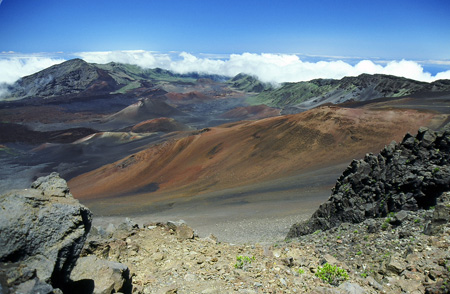Maui Geological Feature #1
Sunday, August 14th, 2011On Maui there is a 10,000-foot high volcano called Haleakala. At the top of the volcano is this geological feature:
This feature is part of Haleakala National Park, and is known as “Haleakala Craterâ€â€”or it was until recently.
The rest of this post is about semantics, culture, and strange bureaucracy.
The National Park Service is apparently in the process of unilaterally changing the name of “Haleakala Crater†to “Haleakala Valley,†which strikes many of us as a heavy-handed and poorly thought-out decision.
First, the disclaimer: I love the National Park Service. I used to work as a seasonal employee at Haleakala National Park, and my husband, now retired, made his career there, which is the reason we live on Maui. The National Park Service is one of the finest, most worthy government organizations out there, staffed with dedicated, hard-working people.
But re-naming the Crater is a mistake. It disrespects the history of a name that’s been in use for nearly 200 years, and it disrespects the culture of this island, which has used the name for all those generations.
Why does the park service want to change the name? According to Mary Evanson in her Maui News opinion piece,
“the National Park Service and the Hawaii Natural History Association (which runs the park shops) were implementing a program […] to educate the public that Haleakala Crater is not a true volcanic crater.â€
I’m going to assume that a “true volcanic crater†really refers to a caldera which, according to thefreedictionary.com is
“A large crater formed by volcanic explosion or by collapse of a volcanic cone.â€
But Haleakala Crater is not a caldera and no one’s calling it “Haleakala Caldera†so this is a non-issue.
The Crater was formed by the erosion of two large amphitheater-headed valleys whose headwalls eventually coalesced at the summit of the aging volcano. A period of extensive volcanism followed and the depression was filled in with lava flows and spotted with cinder cones.
Back to thefreedictionary.com:
cra·ter
1. A bowl-shaped depression at the mouth of a volcano or geyser.
2.
a. A bowl-shaped depression in a surface made by an explosion or the impact of a body, such as a meteoroid.
b. A pit; a hollow.
Hmm, definition 2b seems right on. Colloquial? Maybe, but so what? It’s accurate, traditional, and lyric.
As Mary cites in her viewpoint piece, at one time the term “erosional depression†was considered as the new name for Haleakala Crater, presumably because it was recognized that “valley†just didn’t do the job. Of course “erosional depression†doesn’t take into account the following volcanism, so that term doesn’t work either.
Just for fun, let’s say we agree that “crater†and “valley†and “erosional depression†are all inaccurate and therefore can’t be used. By the same logic, we can no longer call the mountain “Haleakala,†a word usually translated into English as “House of the Sun.†I’ve spent a lot of time in the Crater and I can tell you for a fact that the sun doesn’t actually live there. So just to be sure we don’t mislead anyone with an inaccurate name, maybe we should drop the “Haleakala†and instead call the feature “Maui Geological Feature #1†and leave it at that.
Or maybe we should just stick with the traditional and reasonably accurate name of “Haleakala Crater,†and encourage the National Park Service to spend its very limited money and personnel on more important issues.









